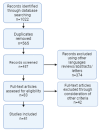Impact of Gut Microbiome Interventions on Glucose and Lipid Metabolism in Metabolic Diseases: A Systematic Review and Meta-Analysis
- PMID: 39598283
- PMCID: PMC11595434
- DOI: 10.3390/life14111485
Impact of Gut Microbiome Interventions on Glucose and Lipid Metabolism in Metabolic Diseases: A Systematic Review and Meta-Analysis
Abstract
Background: The gut microbiome is increasingly recognized as a key player in metabolic health, influencing glucose and lipid metabolism through various mechanisms. However, the efficacy of gut microbiota-targeted interventions, such as probiotics, prebiotics, fecal microbiota transplantation (FMT), and diet-based treatments, remains unclear for specific metabolic outcomes. In this study, the aim was to evaluate the impact of these interventions on the glucose and lipid parameters in individuals with metabolic diseases such as diabetes mellitus (DM), obesity, and metabolic syndrome.
Methods: This systematic review and meta-analysis included 41 randomized controlled trials that investigated the effects of gut microbiota-targeted treatments on metabolic parameters such as fasting glucose, glycated hemoglobin (HbA1c), homeostatic model assessment for insulin resistance (HOMA-IR), total cholesterol, low-density lipoprotein cholesterol (LDL-C), high-density lipoprotein cholesterol (HDL-C), and triglycerides. A comprehensive search was conducted using databases like PubMed, Google Scholar, and Scopus, focusing on interventions targeting the gut microbiota. A meta-analysis was performed using random-effects models, with effect sizes calculated for each outcome. Risk of bias was assessed using the Cochrane Risk of Bias tool.
Results: Gut microbiota-targeted interventions significantly reduced fasting glucose, HbA1c, HOMA-IR, total cholesterol, LDL-C, and triglycerides, with moderate heterogeneity observed across studies. The interventions also led to modest increases in HDL-C levels. Probiotic and synbiotic interventions showed the most consistent benefits in improving both glucose and lipid profiles, while FMT yielded mixed results. Short-term interventions showed rapid microbial shifts but less pronounced metabolic improvements, whereas longer-term interventions had more substantial metabolic benefits.
Conclusions: In this study, it is demonstrated that gut microbiota-targeted interventions can improve key metabolic outcomes, offering a potential therapeutic strategy for managing metabolic diseases. However, the effectiveness of these interventions varies depending on the type, duration, and population characteristics, highlighting the need for further long-term studies to assess the sustained effects of microbiota modulation on metabolic health.
Keywords: FMT; glucose metabolism; gut microbiome; gut microbiome intervention; lipid metabolism; personalized medicine; prebiotic; probiotic; symbiotic.
Conflict of interest statement
The authors declare no conflicts of interest.
Figures



References
Publication types
LinkOut - more resources
Full Text Sources

